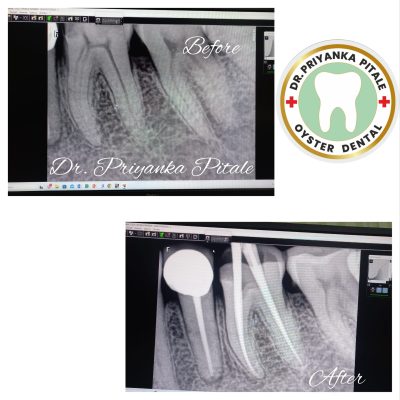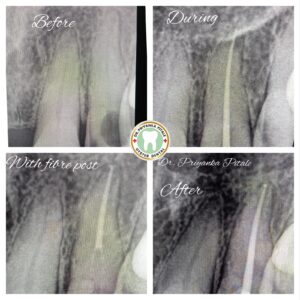
Painless Root Canal Treatment and Reroot Canal Treatment
Advances in dental technology have made painless root canal treatment and painless reroot canal treatment a reality. The procedure includes removing infected / dead pulp from its canals in the roots, cleaning the tooth and flushing the tooth with the medicaments from within, letting the tooth heal, reducing the pain, and eventually filling the pulp canals with an inert rubber-like material, which most of the time is followed by a cap or crown to ensure the coronal seal.
An additional procedure called “Post and Core” has to be conducted in order to strengthen the tooth in case a lot of tooth structure is lost.
Sometimes, root canal-treated teeth get infected again. In such cases, the inert filling material filled inside the root canals earlier has to be removed. The infection inside the bone has to be let out, and after the cleaning procedure has completed and the pain and the infection have subsided, the canals are filled in again by the inert material and medication.
Our super special equipment, such as the “J Morita ZX2 Apex Locator,” helps determine the exact length of the tooth and reduces the possibility of pain throughout the root canal treatment.
Painless root canal treatment and reroot canal treatment are innovative approaches that not only alleviate the discomfort traditionally linked with the procedure but also offer a more efficient and effective solution for patients suffering from severe tooth infections or decay.
This treatment focuses on the use of modern anesthetics and state-of-the-art dental technology to ensure the patient experiences minimal to no pain during the procedure. The primary goal remains the same: to remove the infected or inflamed pulp within the tooth, clean and disinfect the canals, and then fill and seal them to prevent further infection. However, the approach has evolved to significantly enhance patient comfort.
The first step in ensuring a painless experience is the application of a local anesthetic. Dentists today use advanced anesthetics that numb the targeted area more effectively and quickly, ensuring the patient does not feel pain during the procedure. The injection techniques have also improved, making even the administration of the anesthetic more comfortable.
Advanced dental technology plays a crucial role in the success of painless root canal treatment. Tools such as digital radiography allow for more precise imaging, helping the dentist accurately locate the infection and plan the treatment. Rotary endodontic instruments, which are more efficient and less traumatic than traditional hand files, speed up the cleaning and shaping of the root canals.
Additionally, electronic apex locators such as the “J Morita ZX2 Apex Locator” provide precise measurements, ensuring that the canals are thoroughly cleaned without damaging surrounding tissues.

Painless re-root canal treatment
Painless re-root canal treatment, or re-treatment, is necessary when a tooth that has already undergone a root canal treatment becomes re-infected. This can occur if the initial treatment did not completely eliminate the infection or if new decay or damage exposes the canals to bacteria.
Re-root canal treatment follows the same principles as the initial procedure but can be more complex due to the presence of existing fillings or restorations.
During a painless re-root canal treatment, the dentist first removes any previous restorations and re-accesses the canals. Advanced imaging and diagnostic tools are used to locate any remaining infection. The canals are then re-cleaned, disinfected, and sealed using state-of-the-art techniques to ensure long-term success.
In conclusion, this treatments represent a significant advancement in dental care, prioritizing patient comfort without compromising the effectiveness of the procedure. These treatments, facilitated by modern anesthetics and cutting-edge dental technology, ensure that patients can undergo necessary dental procedures without the fear of pain, leading to better dental health outcomes and a more positive experience overall.
As dental technology continues to evolve, the promise of pain-free treatments becomes increasingly attainable, encouraging more patients to seek timely and essential dental care.